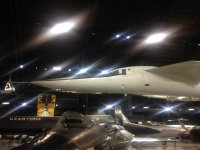Pudsey Bear
Full Member
- Messages
- 15,035
Correct, new a chap some years back who was stationed in the place where they were, he said big puddle under them, tanks and expanion joints closed with heat at altitude also had to be refueled at about 30.000 feet for there long trip.The wet floor in the hanger was fuel dripping from the tanks.
Change your name to W.T.F.When I look at this plane, place it in it's birth decade and look at all the other plane designs of it's era, I can't stop wandering about Roswell and a lot of reverse engineering or even worse, direct alien cooperation. The same with the electronic evolution timeline

Here are a gathering of alien craft at Dayton Ohio.When I look at this plane, place it in it's birth decade and look at all the other plane designs of it's era, I can't stop wandering about Roswell and a lot of reverse engineering or even worse, direct alien cooperation. The same with the electronic evolution timeline


Are you sure? The pilots looked as if they were wearing nappies to me. Quite appropriate I think, I would s..t myself if I went in one of those.The wet floor in the hanger was fuel dripping from the tanks.
Happy to help GGAre you sure? The pilots looked as if they were wearing nappies to me. Quite appropriate I think, I would s..t myself if I went in one of those.
Curious? at 1:57 there is a lady lying prone on the top of the ladder with her head in the pilot's lap. Educate me please, what is she doing? I'm only an innocent young Christian man, I know nothing about fast airplanes and what a pilot has to undergo to fly one.
